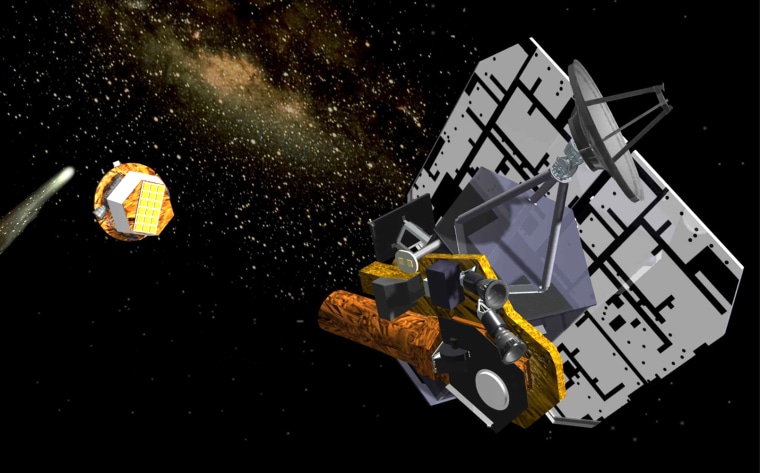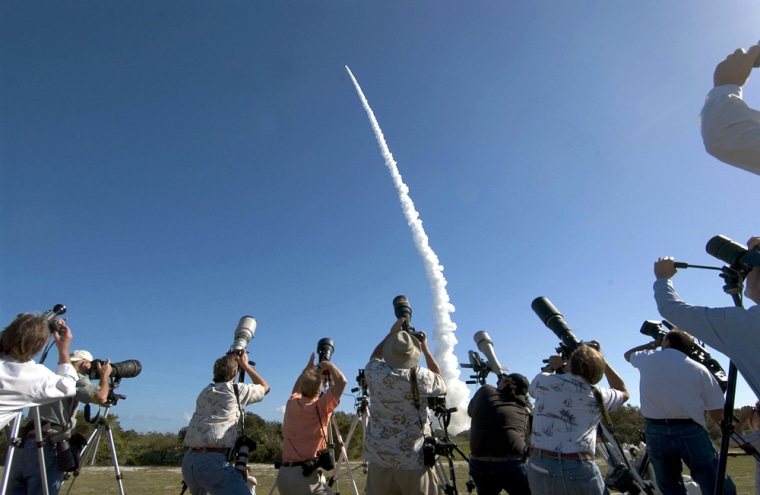A NASA spacecraft with a Hollywood name — Deep Impact — is back to normal and on course to smash a hole in a comet, giving scientists a glimpse of the frozen primordial ingredients of the solar system.
With a launch window only one second long, Deep Impact rocketed away Wednesday at the designated moment to begin a six-month, 268-million-mile (429 million-kilometer) journey to Comet Tempel 1. It will be a one-way trip that NASA hopes will reach a cataclysmic end on the Fourth of July.
“We are on our way,” said an excited Michael A’Hearn of the University of Maryland, the mission’s chief scientist. Minutes later, the spacecraft shot out of Earth’s orbit and onto its collision course.
“We’ll be there July Fourth,” NASA launch director Omar Baez said.
The flight was barely under way when an overheating problem — considered slight and not at all damaging — was detected by the spacecraft itself. Onboard computer software put Deep Impact in a protective “sleep” mode, but recovery commands brought the spacecraft back to full operation.
In a Thursday status report, NASA said the spacecraft was healthy. "We're back on nominal timeline and look forward to our encounter with Comet Tempel 1 this summer." project manager Richard Grammier said.
Shooting at a comet
As the SUV-sized mother ship approaches the comet, it will release a copper-sheathed, TV-sized impactor right into the comet's path. Scientists are counting on the impactor to blast a crater in Comet Tempel 1 that could almost swallow the Roman Colosseum.
It would be humans’ first look into the heart of a comet, a celestial snowball still containing the original building blocks of the sun and the planets.
Because of the relative speed of the two objects at the moment of impact — 23,000 mph (36,800 kilometers per hour) — no explosives are needed for the job. The force of the smashup will be equivalent to 4.5 tons of TNT, creating a flash that just might be visible in the dark sky by the naked eye in one spectacular Fourth of July fireworks display.
Nothing like this has ever been attempted before.
Wrapped in mystery
Little is known about Comet Tempel 1, other than that it is an icy, rocky body about 9 miles long and 3 miles wide (14.4 by 4.8 kilometers). Scientists do not even know whether the crust will be as hard as concrete or as flimsy as corn flakes.

“One of the scary things is that we won’t actually know the shape and what it looks like until after we do the encounter,” said Jay Melosh, a planetary geologist at the University of Arizona.
The comet will be more than 80 million miles (128 million kilometers) from Earth when the collision takes place — on the sunlit side of the comet, NASA hopes, in order to ensure good viewing by spacecraft cameras and observatories. The resulting crater is expected to be two to 14 stories deep, and perhaps 300 feet (90 meters) in diameter.
Scientists stress that Deep Impact will barely alter the comet’s orbital path around the sun and will not put either the comet or a chunk of it on a collision course with Earth. In the 1998 movie “Deep Impact,” astronauts try to blow up a comet in hopes of saving the earth, but the comet winds up being split in two, and one section slams into the Atlantic, creating a huge tsunami on the East Coast.
A jagged, cratered comet like the one headed for Earth in the movie would be difficult if not impossible to hit because of all the shadows, Melosh said. Comet Tempel 1 is believed to be smoother and easier to strike, unlike that “Hollywood nightmare.”
The scientists came up with the Deep Impact name independently of the movie studio, around the same time, neither knowing the other was choosing it, even though some members of NASA’s Deep Impact team were consultants on the picture.
Deep Impact is carrying the most powerful telescope ever sent into deep space. It will remain with the mother ship when the impactor springs free the day before the comet strike, and will observe the event from a safe 300 miles (480 kilometers) away.
NASA space telescopes like the Hubble will also watch the collision, along with ground observatories and amateur astronomers. The impactor will have a camera, too, that will snap pictures virtually all the way in.
The impactor will vaporize instantly when it hits, along with its small payload, a compact disc containing more than 500,000 names of people who wanted to tag along vicariously.
The entire mission costs $330 million, all the way through the grand finale.
This report includes information from The Associated Press and updates from MSNBC.com.
